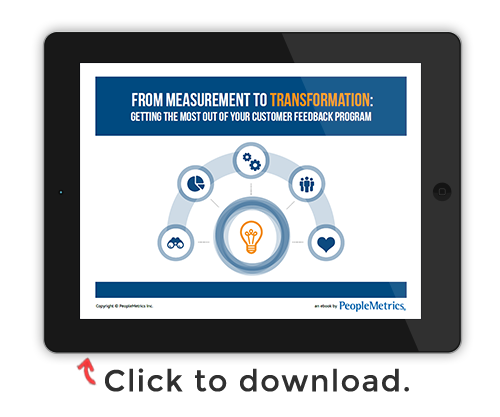 The question of how to measure customer satisfaction is surprisingly complex. It's easy to become lost in the dizzying array of approaches--should you measure customer satisfaction metrics such as loyalty, retention, or emotional attachment? Once you’ve settled on a metric, how will you quantify it based on customer feedback? Here at PeopleMetrics, we’re fanatical about such questions. We help the world’s leading brands improve their customers’ experience by measuring and fostering Customer Engagement. In previous blog posts, we’ve explained why Customer Engagement is the best metric to follow in today’s experience economy. This post explains just how we measure Customer Engagement, and how that approach compares to other popular research techniques.
The question of how to measure customer satisfaction is surprisingly complex. It's easy to become lost in the dizzying array of approaches--should you measure customer satisfaction metrics such as loyalty, retention, or emotional attachment? Once you’ve settled on a metric, how will you quantify it based on customer feedback? Here at PeopleMetrics, we’re fanatical about such questions. We help the world’s leading brands improve their customers’ experience by measuring and fostering Customer Engagement. In previous blog posts, we’ve explained why Customer Engagement is the best metric to follow in today’s experience economy. This post explains just how we measure Customer Engagement, and how that approach compares to other popular research techniques.
The market research methodology landscape is indeed varied, and peppered with many different customer satisfaction metrics. One popular approach is to compare the customer’s expectations with his or her perception of the service or goods received. Another school of thought recommends measuring how likely a customer is to recommend a company’s service to a friend. Still another answer to the question of how to measure customer satisfaction is to ask the consumer to compare his or her experience to the ideal product or service. Some market research firms choose only one tactic; others combine several.
Understanding Customer Satisfaction Metrics
A few challenges are common to all market researchers hoping to measure customer satisfaction. First, how can you be sure that your metric actually influences long-term business outcomes such as profit and ROI? Another issue to consider is how to create surveys that won’t overburden respondents. If you ask too many research questions, the respondents may become irritated—and that irritation could transfer to the brand’s image. A final major concern is that research results can be transferred to front-line employees in order to improve performance.
Customer Engagement Metrics
We’ve balanced all of these research dilemmas in our approach for measuring Customer Engagement. First, in our on-going surveys, we ask four simple questions of each customer to gauge their level of Engagement. Following this, logic is built into the survey such that respondents only answer questions that are relevant to them. This ensures that respondents will not feel frustrated at having to complete a long survey. Below, you’ll find our four questions establishing overall Customer Engagement, along with the characteristic they measure.
-
Retention: “Given the choice, I would do business with [Company] again.”
-
Effort: “I would go out of my way to do business with [Company] in the future.”
-
Advocacy: “I would recommend [Company] to a colleague, friend, or family member.”
-
Passion: “I love doing business with [Company].”
Respondents are asked to agree or disagree with each statement using a 5-point scale, where a 1 indicates “strongly disagree” and a 5 indicates “strongly agree.”
As you can see, our approach includes the best of several other market research methodologies. For instance, by measuring retention and advocacy, we establish the customers’ perceived loyalty and likelihood to recommend to family and friends.
A distinguishing feature of PeopleMetrics’ approach is that it considers the customers’ emotional experience central to overall engagement. By measuring Passion, we encourage customers to provide feedback on their emotional motivation. Consumer motivation has shifted over the last decade or so. As Joseph Pine and others have pointed out, customers are less and less interested in consuming merely for the sake of acquiring more stuff. Today, your customers are looking for a unique purchasing experience as well. In this sense, price and service quality are now akin to entry fees. You can get in the game by having a competitively priced product that consumers want. You can continue to play by offering consistently good service. However, unless you wow the customer at the emotional level, you cannot hope for long-term Customer Engagement—and Customer Engagement is most closely aligned with bottom line results.
[photo: aussiegall]
* * *





%20(1).png)